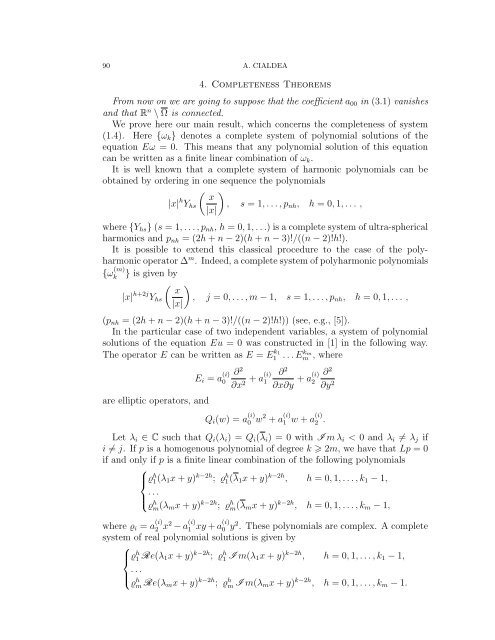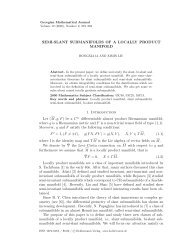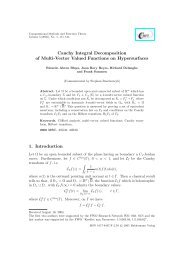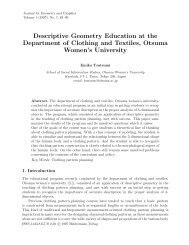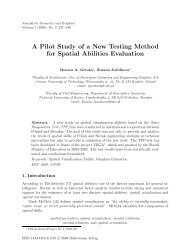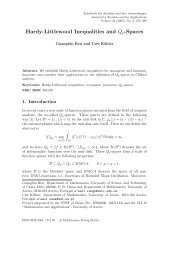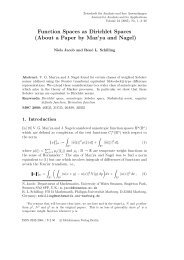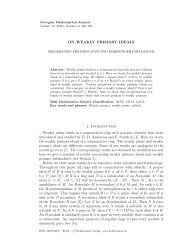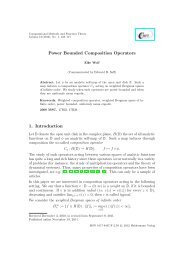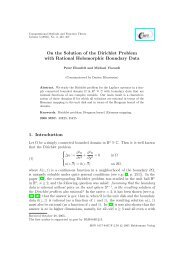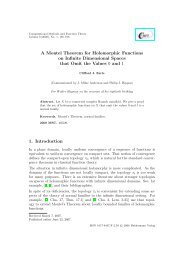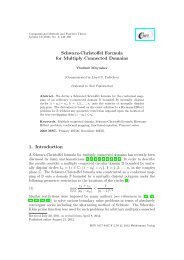COMPLETENESS THEOREMS FOR ELLIPTIC EQUATIONS OF ...
COMPLETENESS THEOREMS FOR ELLIPTIC EQUATIONS OF ...
COMPLETENESS THEOREMS FOR ELLIPTIC EQUATIONS OF ...
You also want an ePaper? Increase the reach of your titles
YUMPU automatically turns print PDFs into web optimized ePapers that Google loves.
90 A. CIALDEA<br />
4. Completeness Theorems<br />
From now on we are going to suppose that the coefficient a 00 in (3.1) vanishes<br />
and that R n \ Ω is connected.<br />
We prove here our main result, which concerns the completeness of system<br />
(1.4). Here {ω k } denotes a complete system of polynomial solutions of the<br />
equation Eω = 0. This means that any polynomial solution of this equation<br />
can be written as a finite linear combination of ω k .<br />
It is well known that a complete system of harmonic polynomials can be<br />
obtained by ordering in one sequence the polynomials<br />
|x| h Y hs<br />
( x<br />
|x|<br />
)<br />
, s = 1, . . . , p nh , h = 0, 1, . . . ,<br />
where {Y hs } (s = 1, . . . , p nh , h = 0, 1, . . .) is a complete system of ultra-spherical<br />
harmonics and p nh = (2h + n − 2)(h + n − 3)!/((n − 2)!h!).<br />
It is possible to extend this classical procedure to the case of the polyharmonic<br />
operator ∆ m . Indeed, a complete system of polyharmonic polynomials<br />
{ω (m)<br />
k<br />
} is given by<br />
|x| h+2j Y hs<br />
( x<br />
|x|<br />
)<br />
, j = 0, . . . , m − 1, s = 1, . . . , p nh , h = 0, 1, . . . ,<br />
(p nh = (2h + n − 2)(h + n − 3)!/((n − 2)!h!)) (see, e.g., [5]).<br />
In the particular case of two independent variables, a system of polynomial<br />
solutions of the equation Eu = 0 was constructed in [1] in the following way.<br />
The operator E can be written as E = E k 1<br />
1 . . . E k m m , where<br />
are elliptic operators, and<br />
E i = a (i)<br />
0<br />
∂ 2<br />
∂ 2<br />
∂ 2<br />
∂x + 2 a(i) 1<br />
∂x∂y + a(i) 2<br />
∂y 2<br />
Q i (w) = a (i)<br />
0 w 2 + a (i)<br />
1 w + a (i)<br />
2 .<br />
Let λ i ∈ C such that Q i (λ i ) = Q i (λ i ) = 0 with I m λ i < 0 and λ i ≠ λ j if<br />
i ≠ j. If p is a homogenous polynomial of degree k 2m, we have that Lp = 0<br />
if and only if p is a finite linear combination of the following polynomials<br />
⎧<br />
⎪⎨ ϱ h 1(λ 1 x + y) k−2h ; ϱ h 1(λ 1 x + y) k−2h , h = 0, 1, . . . , k 1 − 1,<br />
. . .<br />
⎪⎩<br />
ϱ h m(λ m x + y) k−2h ; ϱ h m(λ m x + y) k−2h , h = 0, 1, . . . , k m − 1,<br />
where ϱ i = a (i)<br />
2 x 2 − a (i)<br />
1 xy + a (i)<br />
0 y 2 . These polynomials are complex. A complete<br />
system of real polynomial solutions is given by<br />
⎧<br />
⎪⎨ ϱ h 1 Re(λ 1 x + y) k−2h ; ϱ h 1 I m(λ 1 x + y) k−2h , h = 0, 1, . . . , k 1 − 1,<br />
. . .<br />
⎪⎩<br />
ϱ h m Re(λ m x + y) k−2h ; ϱ h m I m(λ m x + y) k−2h , h = 0, 1, . . . , k m − 1.


